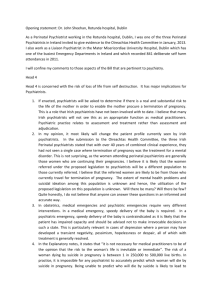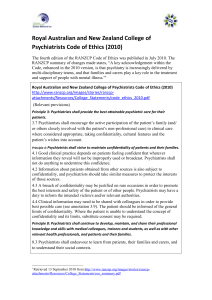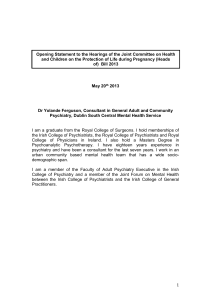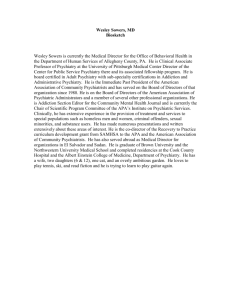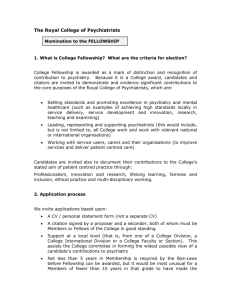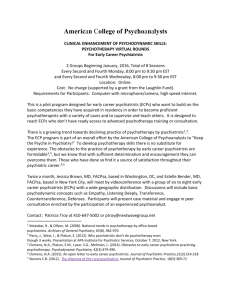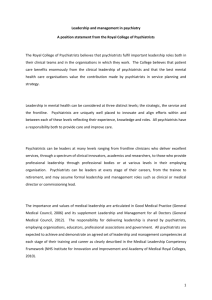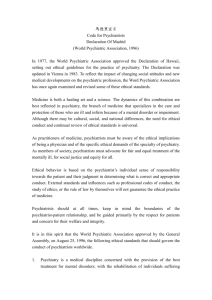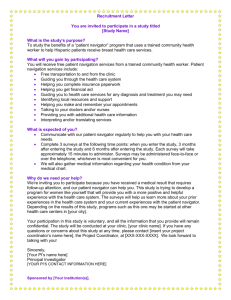Carrying Out A Quality Improvement Initiative During A Public
advertisement
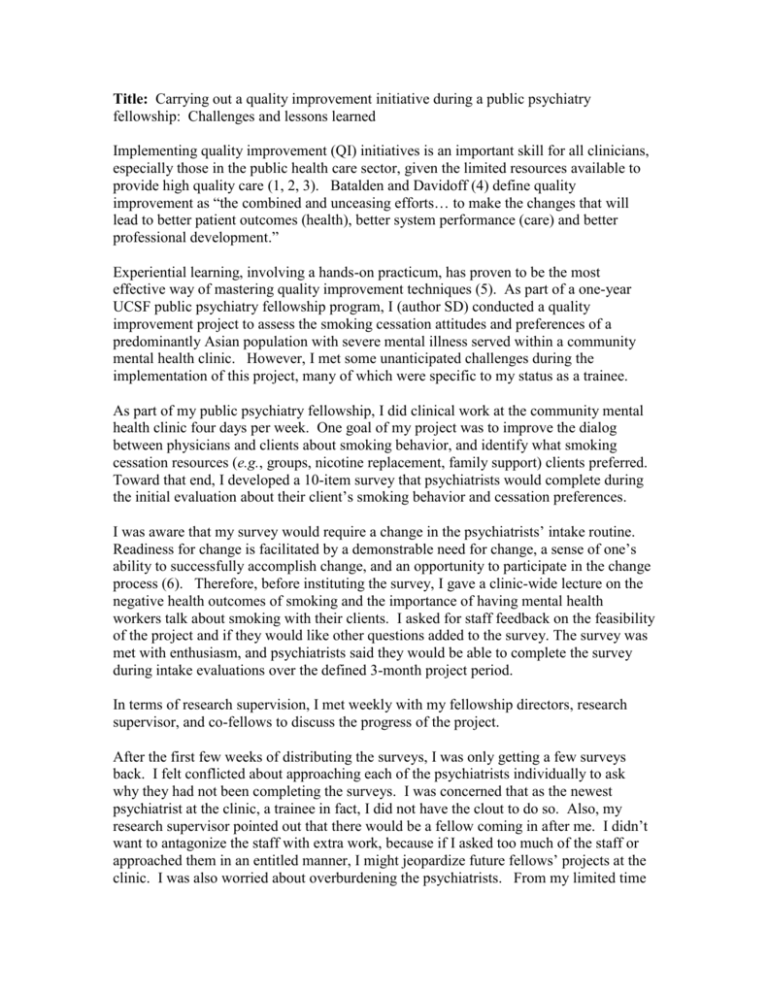
Title: Carrying out a quality improvement initiative during a public psychiatry fellowship: Challenges and lessons learned Implementing quality improvement (QI) initiatives is an important skill for all clinicians, especially those in the public health care sector, given the limited resources available to provide high quality care (1, 2, 3). Batalden and Davidoff (4) define quality improvement as “the combined and unceasing efforts… to make the changes that will lead to better patient outcomes (health), better system performance (care) and better professional development.” Experiential learning, involving a hands-on practicum, has proven to be the most effective way of mastering quality improvement techniques (5). As part of a one-year UCSF public psychiatry fellowship program, I (author SD) conducted a quality improvement project to assess the smoking cessation attitudes and preferences of a predominantly Asian population with severe mental illness served within a community mental health clinic. However, I met some unanticipated challenges during the implementation of this project, many of which were specific to my status as a trainee. As part of my public psychiatry fellowship, I did clinical work at the community mental health clinic four days per week. One goal of my project was to improve the dialog between physicians and clients about smoking behavior, and identify what smoking cessation resources (e.g., groups, nicotine replacement, family support) clients preferred. Toward that end, I developed a 10-item survey that psychiatrists would complete during the initial evaluation about their client’s smoking behavior and cessation preferences. I was aware that my survey would require a change in the psychiatrists’ intake routine. Readiness for change is facilitated by a demonstrable need for change, a sense of one’s ability to successfully accomplish change, and an opportunity to participate in the change process (6). Therefore, before instituting the survey, I gave a clinic-wide lecture on the negative health outcomes of smoking and the importance of having mental health workers talk about smoking with their clients. I asked for staff feedback on the feasibility of the project and if they would like other questions added to the survey. The survey was met with enthusiasm, and psychiatrists said they would be able to complete the survey during intake evaluations over the defined 3-month project period. In terms of research supervision, I met weekly with my fellowship directors, research supervisor, and co-fellows to discuss the progress of the project. After the first few weeks of distributing the surveys, I was only getting a few surveys back. I felt conflicted about approaching each of the psychiatrists individually to ask why they had not been completing the surveys. I was concerned that as the newest psychiatrist at the clinic, a trainee in fact, I did not have the clout to do so. Also, my research supervisor pointed out that there would be a fellow coming in after me. I didn’t want to antagonize the staff with extra work, because if I asked too much of the staff or approached them in an entitled manner, I might jeopardize future fellows’ projects at the clinic. I was also worried about overburdening the psychiatrists. From my limited time at the clinic, I had seen many new “initiatives” being handed down from the County Department of Public Health to the clinics. One example was asking psychiatrists to record height, weight, and blood pressure on each of their patients on medications. The psychiatrists already had extra work, and now I was asking them to do even more. Finally, I only had a limited time frame, which is a formidable barrier to doing research during training (7). I only had one year in which to conceptualize the project, carry it out, analyze the data, and suggest changes. There is significant evidence that top leadership support is needed for successful implementation of any program (8). Therefore, it isn’t surprising that one thing that helped with my lack of clout was having public support from my on-site supervisor, the medical director of the clinic. He was the one who initially told the other psychiatrists that I would be conducting the project, and he continued to show his support during the survey period. He had been at the clinic for many years, and was also able to give me a sense of the burden on the staff, especially the pressures from above that might be affecting psychiatrists’ response to the surveys. Instead of asking psychiatrists why they hadn’t filled out the surveys, one of my supervisors suggested rewarding them with candy and a thank you note in their mailbox for agreeing to participate in the survey, and encouraging them to ask me if they had any questions about the survey. I found that this worked well, and several of the psychiatrists who had not filled out surveys started to do so. At a staff meeting, I also focused on my status as a trainee, appealing to their goodwill to help me with my data collection so that I could complete my fellowship project. Evidence shows that performance monitoring assists with successful implementation as well (8). So, I presented the staff with feedback during the middle of my data collection time period, giving them the percentage of surveys filled out to date. This performance monitoring was helpful as made evident by one of the psychiatrists saying to me at the end of the meeting, “Just keep bugging us!” In the end, I had a 65% response rate to my survey, which is quite good for a physician survey study (9). My experience demonstrated that doing a QI project during a year-long public psychiatry fellowship is feasible, especially with involved supervisors and a receptive audience. In addition to the research findings yielded by the survey, the QI project taught me valuable lessons about implementing a new initiative and the challenges of bringing about organizational change. I learned that utilizing evidence-based implementation strategies is critical, namely having top leadership support, a local champion, including feedback from stakeholders, overcoming local barriers, and providing performance monitoring (8). I hope to take these lessons learned onto my future leadership endeavors. References 1. Berwick DM. Continuous improvement as an ideal in health care. N Engl J Med. 1989; 320(1): 53-56. 2. Headrick LA, Neuhauser D, Schwab P, Stevens DP. Continuous quality improvement and the education of the generalist physician. Acad Med. 1995; 70(1):S104-S109. 3. Wells KB, Sherbourne C, Schoenbaum M, Duan N, Meredith L; Jürgen, U Miranda J, Carney MF, Rubenstein LV. Impact of disseminating quality improvement programs for depression in managed primary care. JAMA. 2000; 283(2):212- 220. 4. Batalden PB, Davidoff F. What is “quality improvement” and how can it transform healthcare? Qual Saf Health Care 2007;16:2-3 5. Boonyasai RT, Windish DM, Chakraborti C, Feldman LS, Rubin HR, Bass EB. Effectiveness of teaching quality improvement to clinicians. JAMA 2007; 298 (9) 10231037. 6. Armenakis AA, Harris SG, Mossholder KW. Creating readiness for organizational change. Human relations 1993; 46: 681-703. 7. Rothberg, MB. Overcoming the obstacles to research during residency: What does it take? JAMA 2012; 308:2191-2192. 8. Fixsen DL, Naoom SF, Blasé KA, Friedman RM & Wallace F. Implementation Research: A Synthesis of the Literature. Tampa, FL: University of South Florida, Louis de la Parte Florida Mental Health Institute, The National Implementation Research Network (FMHI Publication #231), 2005. 9. Kellerman SE, Herold J. Physician response to surveys. A review of the literature. Am J Prev Med. 2001; 20:61-67.

